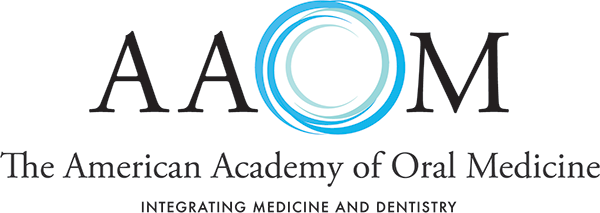Subject: Medical HistoryThe AAOM affirms that understanding the medical health of dental patients is important for proper dental care and the overall health of the patient. Originator: Dr.Craig Miller, DMD, MSThis Clinical Practice Statement was developed as an educational tool based on expert consensus of the American Academy of Oral Medicine (AAOM) leadership. Readers are encouraged to consider the recommendations in the context of their specific clinical situation, and consult, when appropriate, other sources of clinical, scientific, or regulatory information prior to making a treatment decision. Originator: Dr. Craig Miller, DMD, MS Review: AAOM Education Committee Approval: AAOM Executive Committee Adopted: August 1, 2013 Updated: January 2, 2016 Purpose The AAOM affirms that understanding the medical health of dental patients is important for proper dental care and the overall health of the patient. Methods This statement is based on a review of the current dental and medical literature related to the importance of a current medical history. A MEDLINE search was conducted using the terms “medical history,” “dentistry,” and “dental practice.” Expert opinions and best current practices were relied upon when clinical evidence was not available. Background More than 200,000,000 persons seek dental care annually in the United States.1 There is an expectation that dental care is provided to these patients in a safe and effective manner. When a patient makes regular, non-emergent visits to the same dentist for treatment (i.e., has a dental home), the dentist may be quite familiar with the patient and the patient’s family. However, not all dental care is regularly scheduled, and many patients receive care in an episodic manner. Whether the care is routine or episodic, the dentist is responsible for the proper evaluation of the patient. An important initial step in the evaluation process is taking a thorough medical history. The medical history should accurately reflect the past and current health status of the patient. The history is derived from information provided by the patient and can be obtained from written information on a standardized form or electronically.2 Health history information may also be obtained from prior medical or dental records or from family or caregivers. Regardless of the mode, the medical history should be a thorough and accurate assessment of the patient’s systemic conditions and diseases and include evaluation of organ dysfunction and inflammatory, infectious, metabolic, degenerative, and neoplastic diseases, as well as past and present medical therapies.2,3 The dentist should be aware that medical history questionnaires and information supplied by patients regarding their medical history do not always provide accurate information4,5 and that referral letters are often incomplete.6 Thus, the method of dialogue with the patient should be utilized to review the historical information and confirm its accuracy.7 Methods should be employed such that the patient is notified in advance of the appointment to bring information regarding current and past medical conditions; primary care physician’s name, address, and phone number; and a list of current and past medications, including alternative or homeopathic formulations. A complete medical history is helpful in identifying not only existing disease conditions but also disease severity and stability.8 This information, in turn, is important for understanding the potential relationships among, and the impact of, systemic health, medications, and past and current therapeutic interventions on the patient’s orofacial health and the ability of the patient to tolerate dental treatment. Policy Statement
This Clinical Practice Statement was developed as an educational tool based on expert consensus of the American Academy of Oral Medicine (AAOM) leadership. Readers are encouraged to consider the recommendations in the context of their specific clinical situation, and consult, when appropriate, other sources of clinical, scientific, or regulatory information prior to making a treatment decision. |
